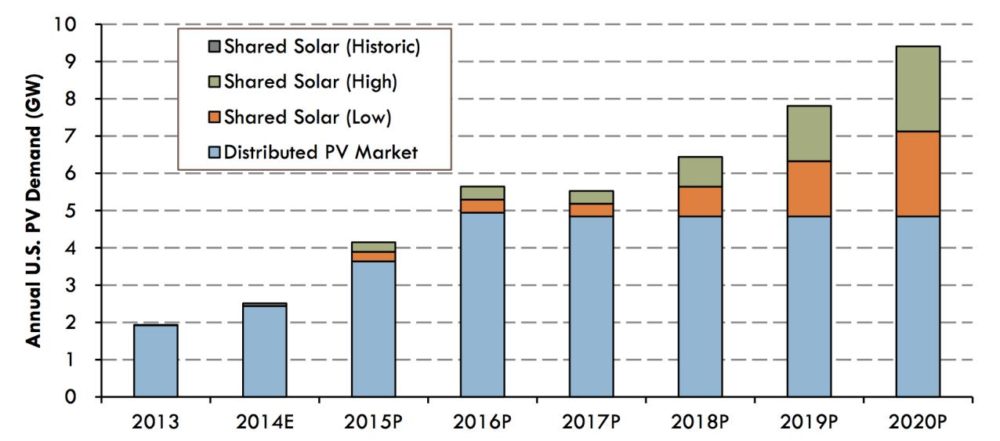Community solar is a powerful and effective tool for increasing access to the solar revolution. That’s one of the key takeaways from research recently completed by UCS’s 2016 Schneider Fellow, Thazin. For nearly 15 years, UCS has participated in Stanford University’s Schneider Fellowship Program, which pairs talented students with national nongovernmental organizations (NGOs) to work on issues in support of sustainable energy. The dispatch below—penned by Thazin—summarizes her work on the exciting role that community solar can play in the transition to a clean energy economy.

Thazin, UCS 2016 Schneider Fellow
Every year, generating power from the sun is becoming more and more affordable across the country. Even so, rooftop solar is still not accessible to many Americans. Perhaps your home is not suitable for solar because of size, orientation, shading, or material. Or perhaps you rent your house or apartment.
Accounting for just those roof-related barriers, an NREL study estimates that 49% of households in America are unable to install solar on their homes. And even if the roof is solar friendly, financing a solar photovoltaic (PV) system may be difficult because of credit scores or cumbersome regulations, making rooftop solar even more inaccessible to households and small businesses.
While rooftop solar may not be an option for you, going solar is not a lost cause. You might still be able to enjoy many of the benefits from investing in solar by participating in community solar projects.
What is community solar?
Similar to the concept of a community garden, community solar, also known as solar gardens or shared solar, refer to local solar projects or programs in which multiple subscribers can access and benefit from the electricity produced. Instead of fresh produce, community solar subscribers typically get utility bill credits for the power produced by their share of the community solar project, without having installed solar PV on their own roofs.
As a subscriber, you don’t have to worry about maintenance, and you often have the option to transfer your benefits if you move in the same utility territory service area. Buying a piece of a larger system (and one well-oriented for solar production) can also bring you economies of scale, which could translate to more savings.
Because of these reasons, community solar can also be attractive to home and business owners with adequate rooftop solar potential.

Community Solar Project at the Rainshadow Community Charter High School in Reno, Nevada (Black Rock Solar/Flickr)
Commonly, community solar projects can be hosted by your own utility or a third party organization. Third party organizations can be national organizations such as Clean Energy Collective LLC, operating community solar programs across the country. They can be community-driven projects in which projects are initiated by the leadership of local community members as well.
Because community solar projects are usually located locally, your choices will be limited to the programs that are available in your utility territory.
How do community solar finances work?
Like rooftop solar, utility and third party community solar providers may offer leasing and ownership options for your share of the community solar project. They may also offer a subscription-based option. As shown in Figure 1, providers can present a variety of financing packages for each option. For instance, when buying a portion of the panels in a solar farm, you may be able to make single up-front payment or multiple monthly payments. For subscription-based models, you may be able to lock in a fixed rate over the life time of the project or an escalating rate for solar that starts lower and increases over time.

Figure 1: Community Solar Enrollment Options (Based on Energy Sage)
When evaluating programs offerings, one key consideration is how quickly you’d like to see a return on investment (e.g., payback period) from subscribing to the project. Here are a few things to keep in mind when estimating your potential savings:
- Input assumptions: Depending on your local utility, project, and even state, several factors can impact your bill savings, including: increases in utility rates; the rate at which the PV system degrades over time; applicable utility, state, or federal solar incentives; and more broadly, inflation rates.
- Program length and exit option: Most programs will allow you to subscribe to the community solar program for the system lifetime, which is normally around 20 to 25 years. Depending on the program, you can typically transfer your program if you move within the same utility area.
- Fees: Some programs may also charge an early termination fee for breaking a contract early. For subscription-based models, there may be a membership fee and or a recurring administrative fee for enrolling in the program.
You can use freely available calculators to evaluate your potential savings.
The future is bright for community solar
Community solar projects have become increasingly popular since the first project in the US came online in 2006. Currently, community shared solar capacity amounts to more than 172 MW of power, enough to power 28,000 average American homes. Projects exist in 25 states, and 15 of those states (including Maryland in 2016, and Washington D.C.) have policies in place that support community solar. In 2015 alone, seven states advanced policies on community solar, and many others are evaluating policies to enable more community solar projects. Because of the increasingly supportive regulatory environment and growing interest in community solar, community solar could contribute to 32% to 49% of solar installations by 2020 (Figure 2).

Figure 2: Estimated Market Potential for Shared Solar (NREL, 2016)
In our transition to a clean energy economy, renewable energy on both sides of the electric meter will play an important role in decarbonizing the electricity sector. To that end, community solar is such a promising option for so many people without access to rooftop solar. With the economies of scale that community solar can bring, subscribers can benefit financially from savings, while making a renewable energy future happen, one kilowatt at a time.
